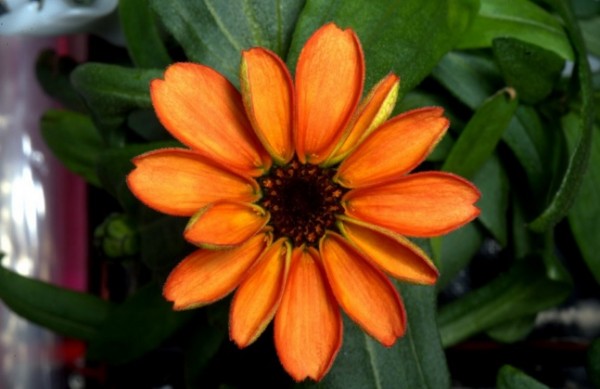By Ana Verayo, | January 18, 2016

This orange zinnia is the first flower to bloom in space, aboard the International Space Station.
For the first time ever, a flower has bloomed in space under zero gravity conditions. NASA astronaut Scott Kelly revealed this breakthrough when a zinnia plant has already transformed into a flower on the International Space Station.
Like Us on Facebook
Kelly posted a photo on his Twitter account of this orange space zinnia blooming with 13 petals, stating that this is the first ever flower grown in space making its debut! adding that there are apparently "other life forms" in space.
NASA also revealed why zinnias were chosen to grow in lower Earth orbit, where scientists say that they were not chosen because of their beauty but for the fact that they will be able to help scientists to understand how plants grow and produce flowers in microgravity.
Prior to this beautiful spaceflower, NASA revealed curled up, wilted zinnias with moldy leaves just this late December. He said, our plants are not looking too good, and this would be a problem for a human colony on Mars.
Apart from this zinnia bloom, plants like lettuce and wheat have already grown in space, however this marks the first flower to do so. According to project manager for the International Space Station, Trent Smith, who manages the plant and vegetable growing facility, the zinnia plant is totally different from the lettuce since it is more sensitive to environmental parameters and light characteristics, requiring 60 to 80 days to grow.
With a longer growth duration, the zinnia is more difficult to grow since you have to allow a longer period for it to bloom, making this a good precursor to a tomato plant.
Apart from helping scientists to figure out how to grow useful plants in space for future human colonies on Mars, it is also believed that the blooming flower's presence can lift spirits among the crew aboard the space station.
According to NASA Human Research Program's Alexandra Whitmire, plants can enhance long duration missions especially in isolation or extremely confined environments like those that are artificial and are deprived of nature. Not all crew members are keen on taking care of plants, however, this option could be beneficial for others.
In future missions, especially those that will take months of even years in transit, plants will be crucial in increasing the astronauts' limited connection to Earth. Studies have shown that in isolated or confined environments such as stations located in the Arctic and Antarctic regions, the presence of plants becomes more important than ever. Psychologically, the presence of fresh food is also as crucial, where there is little stimuli around.
-
Use of Coronavirus Pandemic Drones Raises Privacy Concerns: Drones Spread Fear, Local Officials Say

-
Coronavirus Hampers The Delivery Of Lockheed Martin F-35 Stealth Fighters For 2020

-
Instagram Speeds Up Plans to Add Account Memorialization Feature Due to COVID-19 Deaths

-
NASA: Perseverance Plans to Bring 'Mars Rock' to Earth in 2031

-
600 Dead And 3,000 In The Hospital as Iranians Believed Drinking High-Concentrations of Alcohol Can Cure The Coronavirus

-
600 Dead And 3,000 In The Hospital as Iranians Believed Drinking High-Concentrations of Alcohol Can Cure The Coronavirus

-
COVID-19: Doctors, Nurses Use Virtual Reality to Learn New Skills in Treating Coronavirus Patients







